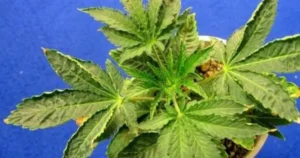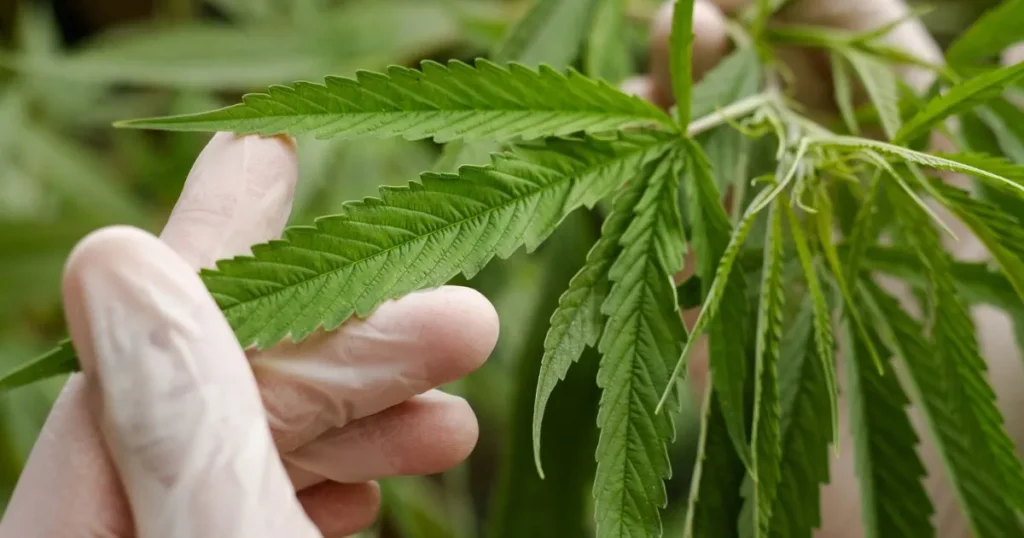Whether growing cannabis for medical or recreational uses, plant health and vitality must be carefully monitored; cannabis leaf curl down is one of the many recurring problems that farmers deal with, and it can greatly impact crop productivity and quality.
Cannabis leaves exhibiting this phenomenon—characterized by a downward curl—are frequently signs of underlying pressures that require immediate care. We explore the main reasons for cannabis leaf curl down in this thorough tutorial and offer doable fixes to address these problems.
Maintaining healthy and thriving cannabis plants requires knowing the underlying causes of leaf curl down and implementing effective remedies, whether you’re a seasoned producer or a newbie gardener. Learn about the nuances of cannabis leaf health and leave with the knowledge necessary to raise healthy, hardy plants.
Knowing Why Cannabis Leaf Curl Down:
Cannabis leaf curl down is a common term for the characteristic downward curling of the plant’s leaves, which is frequently accompanied by other apparent signs like browning or withering. In addition to its aesthetic value, this phenomenon is an important sign of the plant’s general health and well-being. If left untreated, leaves curling down weed can negatively impact a plant’s ability to develop, yield, and remain vibrant.
The plant’s capacity to create energy and vital nutrients is hampered by the cannabis leaf tips curling down, which interferes with photosynthesis. As a result, there may be less cannabinoid in harvested buds, less flowering, and limited growth.
Furthermore, the plant’s immune system may be weakened by the underlying stresses that cause leaves curling down during flowering, whether dietary, environmental, or pest-related. This leaves the plant more vulnerable to illnesses and other ailments. For this reason, minimizing the harmful effects of leaves curling down weed, protecting the health of the plant, and increasing crop yield all depend heavily on prompt detection and response.
Common Reasons for Curling Cannabis Leaves:

- Environmental Factors: Cannabis leaf curl down in response to environmental stressors. Temperature variations, particularly sharp heat or cold waves, can cause plants to go into physiological stress, resulting in curled leaves. Furthermore, low or high humidity levels can interfere with transpiration mechanisms, which can influence leaf turgidity and cause curling. Furthermore, excessive or insufficient light exposure can result in photoinhibition, which affects photosynthesis and causes to weed leaves curling down.
- Nutrient Deficiencies: Cannabis plants require adequate vital nutrients in a balanced form for ideal development and growth. Key nutritional deficiencies can occur in potassium, phosphorus, and nitrogen manifest through symptoms like leaf curling, discoloration, and necrosis. Nitrogen deficiency, for instance, leads to overall chlorosis and reduced leaf size, while phosphorus deficiency can cause dark green or purple foliage with curled leaf margins. Similarly, potassium deficiency results in leaf tip necrosis and curling, compromising the plant’s ability to regulate water and nutrient uptake.
- Deficiencies in Nutrients: For optimum growth and development, cannabis plants need a balanced supply of key nutrients. Necrosis, yellowing, and curling of the leaves are signs of deficiencies in important nutrients like potassium, phosphate, and nitrogen. For example, a lack of nitrogen causes chlorosis and smaller leaves, whereas a lack of phosphorus might result in dark green or purple foliage with curled leaf margins. In a similar vein, a potassium deficit causes necrosis and curling of the leaf tips, impairing the plant’s capacity to control the intake of nutrients and water.
- Pests and Diseases: Cannabis plants may have stress responses to insect infestations, such as aphids, thrips, and spider mites, which may cause the plants to curl their leaves in defense. These pests harm leaf structures and interfere with regular growth patterns because they feed on plant tissues. Furthermore, leaf curling may result from fungal infections such as powdery mildew or botrytis, which infect leaf surfaces and disrupt physiological functions.
- Overwatering or Underwatering: Water stress from improper watering techniques, such as overwatering or underwatering, can cause cannabis plants’ leaves to curl. Overwatering causes the soil to get saturated, suffocating the roots and preventing them from taking in oxygen. This reduces the turgidity of the leaves and causes them to curl. Conversely, plants that are submerged in water lose vital moisture, which causes them to wilt and curl in an attempt to conserve water and decrease transpiration.
- pH imbalance: The growing medium’s pH level greatly impacts the availability and uptake of nutrients by cannabis plants. An imbalance in pH, either too acidic or too alkaline, can make it difficult for the plant to take in necessary nutrients, which can cause shortages and leaf curling. Alkaline pH levels can limit phosphorus uptake, decreasing overall plant health and vigor, whereas acidic soil pH can cause nutrient lockout, especially micronutrients like iron and manganese. Leaf curling caused by pH imbalances must be avoided by routinely checking and adjusting pH levels.
Growers may promote plant health and maximize crop yields by efficiently identifying and addressing underlying issues. By knowing these typical causes of weed leaves curling down, growers may prevent leaf curling and guarantee the robust development and expansion of their cannabis plants by putting in place the proper corrective measures suited for the particular reason.
How to Correct Curl in Cannabis Leaves:
1. Environmental Management:
- Humidity and Temperature Control: To reduce stress on cannabis plants, keep the growth environment at the ideal humidity and temperature levels. Use fans, humidifiers, or heaters to establish a comfortable temperature as needed.
- Lighting Adjustment: To avoid photoinhibition and weed leaves are curling down, ensure the light is present for the right amount of time and intensity. Change the spacing between plants and grow lights to prevent overheating or light stress.
2. Nutrient management:
- Soil amendment: To address deficiencies or imbalances, test the soil’s pH and nutrient levels regularly and supplement the soil as necessary. To supply necessary macro- and micronutrients, use organic fertilizers or balanced nutrition solutions.
- Foliar feeding: Use foliar sprays containing micronutrients like iron, magnesium, and zinc to enhance nutrition absorption. For best absorption, apply foliar fertilizers when the plant is actively growing.
3. Disease and Pest Control:
- Integrated Veterinary Practices (IPM): To effectively manage pests and diseases, implement preventive measures such as routine scouting, cleanliness, and biological controls. Use botanical pesticides, neem oil, or insecticidal soaps for non-toxic pest control.
- Application of Fungicides: Use fungicides or bio fungicides to eradicate fungal infections like botrytis or powdery mildew. Follow the manufacturer’s recommendations for safety precautions when utilizing chemical treatments.
4. Watering Methods:
- Water management: Regularly check the soil’s moisture content and modify the volume and frequency of watering. To avoid suffocating the roots with too much water, let the soil dry out a little bit between irrigations. Use growth media that drain effectively for better aeration and root health.
- Water quality: To prevent, use filtered or distilled water toxic accumulation in the soil or nutritional imbalances. Chlorinated and fluoridated water should not be used, as these chemicals can damage plant roots and vital soil bacteria.
5. PH Adjustment:
- PH Testing: To guarantee that the growing medium and nutrient solution have the right amounts of acidity or alkalinity, test their pH on a regular basis. For precise measurements, use test kits or pH meters.
- PH Correction: To modify the pH of soil or water, use pH adjusters, such as sulfur for alkaline soils or dolomite lime for acidic soils. Adjust the pH gradually to prevent abrupt changes that can stress plants.
Restoring plant health and vigor requires putting these remedial measures—tailored to the particular cause of weed leaves are curling down into practice. Leaf curling can be reduced, and optimal development and productivity in cannabis crops can be promoted by farmers by swiftly and efficiently resolving environmental stresses, nutrient deficits, pest infestations, hydration concerns, and pH imbalances. Proactive management techniques and routine monitoring maintain robust and healthy plants throughout the cultivation cycle.
Prevention and Maintenance Tips:

The best course of action for controlling cannabis leaf curl down and preserving general plant health is frequent prevention.
By taking preventive measures, growers may ensure thriving crops and reduce the possibility of leaf curling. To avoid environmental stressors that can cause leaf curling, it’s critical to maintain ideal growing conditions, including temperature, humidity, and light levels. It is also essential to regularly monitor the pH balance, nutrient levels, and soil moisture to spot possible problems early and take appropriate action.
Furthermore, maintaining proper sanitation and hygiene in the growing area reduces the chance of insect and disease outbreaks, which in turn reduces the chance of leaf curling due to infections or infestations. Growers can respond quickly to problems by keeping up to date on best practices in cannabis production and paying close attention to signs of plant health. Growers may limit the occurrence of weed leaves curling down and nurture robust, healthy cannabis crops by being proactive and attentive to the demands of their plants.
In Summary:
To maintain the health and vitality of your cannabis plants, you must comprehend the primary causes of cannabis leaf curl down and apply efficient remedies.
Growers can minimize leaf curling and encourage ideal development and productivity in their cannabis crops by managing environmental stressors, nutrient deficits, pest infestations, hydration problems, and pH imbalances. Recall to be proactive in preserving ideal growing circumstances, routinely checking plant health indicators, and responding quickly to any problems that may occur.
Growers can cultivate healthy, thriving cannabis plants and reap the rewards of a well-informed and hardworking crop. Remember these tips while you tend to your plants, and I hope your gardening experience is full of abundant harvests and thriving crops.
Frequently Asked Questions:
1. What is cannabis leaf curl down?
Cannabis leaf curl down refers to the downward curling of the plant’s leaves, often accompanied by other symptoms such as discoloration or wilting. It is indicative of underlying stressors that can impact plant health and vitality.
2. What are the top causes of cannabis leaf curl down?
Environmental elements, including humidity and temperature swings levels, nutrient deficiencies (e.g., nitrogen, phosphorus, and potassium), pest infestations, diseases, overwatering or underwatering, and pH imbalances, are the top causes of cannabis leaf curl down.
3. How do I prevent cannabis leaf from curling down?
Prevention involves maintaining optimal growing conditions, including temperature, humidity, light intensity, and soil pH. Regularly monitoring plant health indicators, such as leaf color and turgidity, can help identify issues early on and prevent leaf curling.
4. Can cannabis leaf curl down be a sign of nutrient deficiency?
Yes, cannabis leaf curl down can be a sign of nutrient deficiency, particularly in essential nutrients such as nitrogen, phosphorus, and potassium. Monitoring nutrient levels and providing balanced fertilization can help prevent nutrient-related leaf curling.

